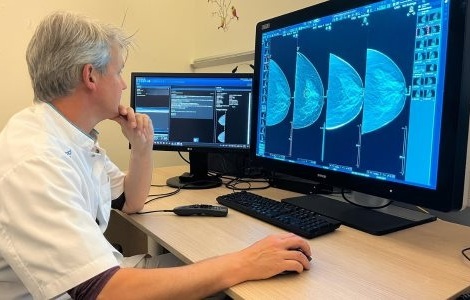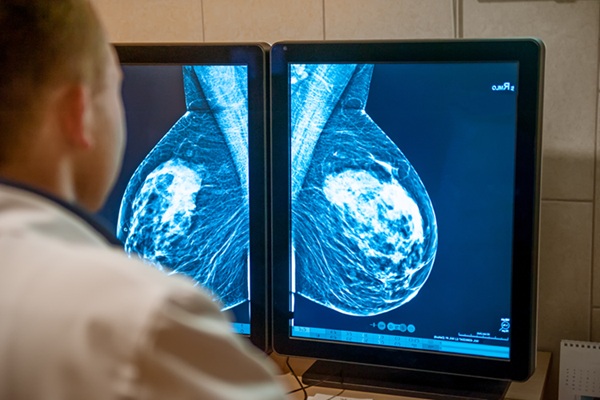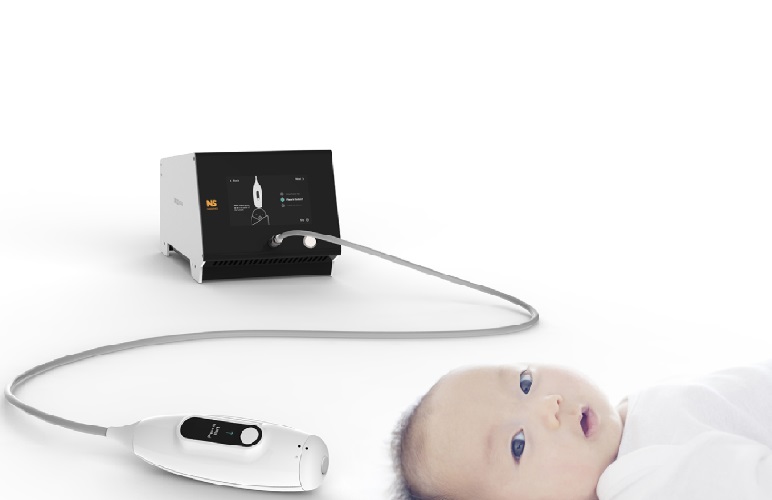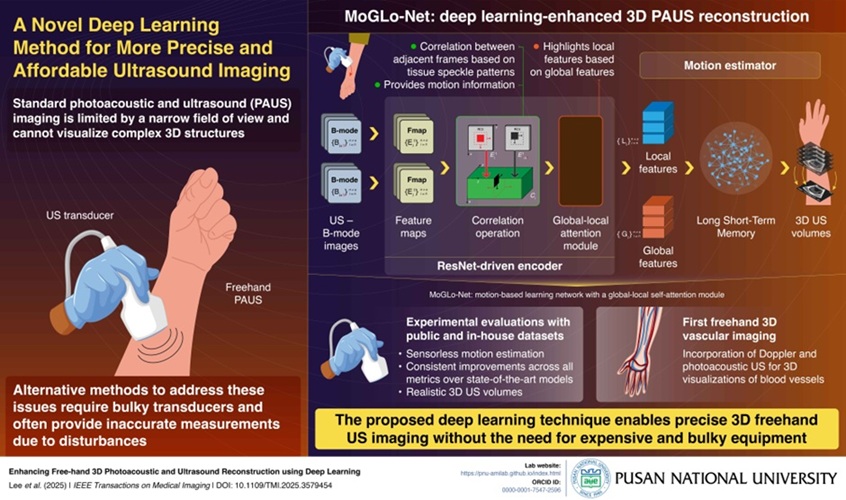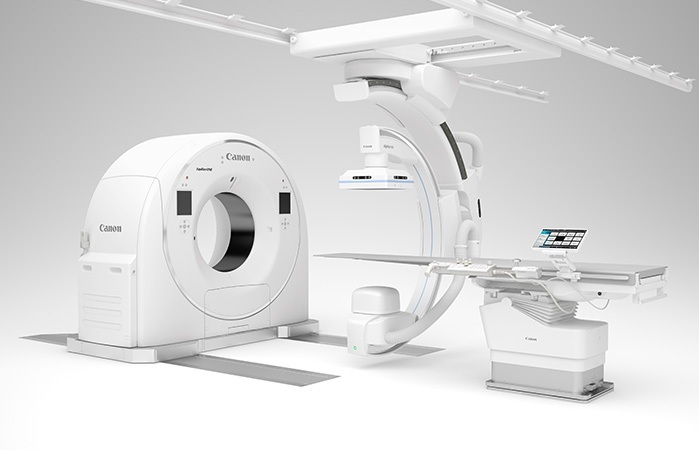Single-Dose IORT Offsets COVID-19 Compliance Issues
|
By MedImaging International staff writers Posted on 07 Jan 2021 |

Image: The Zeiss Intrabeam 600 IORT system (Photo courtesy of Zeiss)
A long-term study show that targeted intraoperative radiotherapy (IORT) is equivalent to the traditional six-week radiotherapy (RT) regimen for early breast cancer (BC), reducing potential exposure to COVID-19.
Researchers at University College London (UCL; United Kingdom), Centro di Riferimento Oncologico di Aviano (CRO; Italy), and 30 other centers in 10 countries conducted a prospective, open label, randomized study to determine if single dose IORT during lumpectomy can effectively replace postoperative external beam radiotherapy (EBRT) for early BC. In all, 2,298 women with cN0-N1 invasive ductal carcinoma up to 3.5 cm in size were randomized before lumpectomy to risk adapted targeted IORT or EBRT.
The results demonstrated equal BC recurrence and survival rates among recipients of targeted IORT and those receiving multiple weeks of whole breast EBRT following lumpectomy. Long term follow-up of up to 18.9 years showed no significant difference in the five year local recurrence rates and 8.6 year local recurrence-free survival rates, BC survival rate, and overall survival rate. Women receiving targeted IORT also had a significantly lower risk of dying from other causes, such as heart disease or other cancers. The study was published on August 19, 2020, in BMJ.
“The long term results of this trial have shown that risk adapted single dose targeted IORT given during lumpectomy can effectively replace the mandatory use of several weeks of daily postoperative EBRT in patients with BC undergoing breast conservation,” concluded lead author Professor Jayant Vaidya, MD, of UCL, and colleagues. “Crucially, 80% of the patients required no additional radiotherapy; additionally, targeted IORT reduced non-breast cancer mortality. The advantage to the patient of avoiding post-operative radiotherapy could be considered obvious.”
“Unlike EBRT, which requires up to 30 visits to the radiotherapist, targeted IORT achieves the same clinical outcomes with one dose of targeted radiation delivered from inside the breast during surgery immediately following the removal of the tumor,” said Neil Friedman, MD, director of The Hoffberger Breast Center at Mercy Medical Center (Baltimore, MD, USA), who was not involved in the study. “Not only does targeted IORT mitigate the side effects normally associated with irradiating the entire breast multiple times, it may lessen or even eliminate unsafe additional outside trips during the pandemic.”
Related Links:
University College London
Centro di Riferimento Oncologico di Aviano
Researchers at University College London (UCL; United Kingdom), Centro di Riferimento Oncologico di Aviano (CRO; Italy), and 30 other centers in 10 countries conducted a prospective, open label, randomized study to determine if single dose IORT during lumpectomy can effectively replace postoperative external beam radiotherapy (EBRT) for early BC. In all, 2,298 women with cN0-N1 invasive ductal carcinoma up to 3.5 cm in size were randomized before lumpectomy to risk adapted targeted IORT or EBRT.
The results demonstrated equal BC recurrence and survival rates among recipients of targeted IORT and those receiving multiple weeks of whole breast EBRT following lumpectomy. Long term follow-up of up to 18.9 years showed no significant difference in the five year local recurrence rates and 8.6 year local recurrence-free survival rates, BC survival rate, and overall survival rate. Women receiving targeted IORT also had a significantly lower risk of dying from other causes, such as heart disease or other cancers. The study was published on August 19, 2020, in BMJ.
“The long term results of this trial have shown that risk adapted single dose targeted IORT given during lumpectomy can effectively replace the mandatory use of several weeks of daily postoperative EBRT in patients with BC undergoing breast conservation,” concluded lead author Professor Jayant Vaidya, MD, of UCL, and colleagues. “Crucially, 80% of the patients required no additional radiotherapy; additionally, targeted IORT reduced non-breast cancer mortality. The advantage to the patient of avoiding post-operative radiotherapy could be considered obvious.”
“Unlike EBRT, which requires up to 30 visits to the radiotherapist, targeted IORT achieves the same clinical outcomes with one dose of targeted radiation delivered from inside the breast during surgery immediately following the removal of the tumor,” said Neil Friedman, MD, director of The Hoffberger Breast Center at Mercy Medical Center (Baltimore, MD, USA), who was not involved in the study. “Not only does targeted IORT mitigate the side effects normally associated with irradiating the entire breast multiple times, it may lessen or even eliminate unsafe additional outside trips during the pandemic.”
Related Links:
University College London
Centro di Riferimento Oncologico di Aviano
Latest Nuclear Medicine News
- New Imaging Solution Improves Survival for Patients with Recurring Prostate Cancer
- PET Tracer Enables Same-Day Imaging of Triple-Negative Breast and Urothelial Cancers
- New Camera Sees Inside Human Body for Enhanced Scanning and Diagnosis
- Novel Bacteria-Specific PET Imaging Approach Detects Hard-To-Diagnose Lung Infections
- New Imaging Approach Could Reduce Need for Biopsies to Monitor Prostate Cancer
- Novel Radiolabeled Antibody Improves Diagnosis and Treatment of Solid Tumors
- Novel PET Imaging Approach Offers Never-Before-Seen View of Neuroinflammation
- Novel Radiotracer Identifies Biomarker for Triple-Negative Breast Cancer
- Innovative PET Imaging Technique to Help Diagnose Neurodegeneration
- New Molecular Imaging Test to Improve Lung Cancer Diagnosis
- Novel PET Technique Visualizes Spinal Cord Injuries to Predict Recovery
- Next-Gen Tau Radiotracers Outperform FDA-Approved Imaging Agents in Detecting Alzheimer’s
- Breakthrough Method Detects Inflammation in Body Using PET Imaging
- Advanced Imaging Reveals Hidden Metastases in High-Risk Prostate Cancer Patients
- Combining Advanced Imaging Technologies Offers Breakthrough in Glioblastoma Treatment
- New Molecular Imaging Agent Accurately Identifies Crucial Cancer Biomarker
Channels
Radiography
view channel
AI Generates Future Knee X-Rays to Predict Osteoarthritis Progression Risk
Osteoarthritis, a degenerative joint disease affecting over 500 million people worldwide, is the leading cause of disability among older adults. Current diagnostic tools allow doctors to assess damage... Read more
AI Algorithm Uses Mammograms to Accurately Predict Cardiovascular Risk in Women
Cardiovascular disease remains the leading cause of death in women worldwide, responsible for about nine million deaths annually. Despite this burden, symptoms and risk factors are often under-recognized... Read moreMRI
view channel
AI-Assisted Model Enhances MRI Heart Scans
A cardiac MRI can reveal critical information about the heart’s function and any abnormalities, but traditional scans take 30 to 90 minutes and often suffer from poor image quality due to patient movement.... Read more
AI Model Outperforms Doctors at Identifying Patients Most At-Risk of Cardiac Arrest
Hypertrophic cardiomyopathy is one of the most common inherited heart conditions and a leading cause of sudden cardiac death in young individuals and athletes. While many patients live normal lives, some... Read moreUltrasound
view channel
Ultrasound Probe Images Entire Organ in 4D
Disorders of blood microcirculation can have devastating effects, contributing to heart failure, kidney failure, and chronic diseases. However, existing imaging technologies cannot visualize the full network... Read more
Disposable Ultrasound Patch Performs Better Than Existing Devices
Wearable ultrasound devices are widely used in diagnostics, rehabilitation monitoring, and telemedicine, yet most existing models rely on lead-based piezoelectric ceramics that pose health and environmental risks.... Read moreGeneral/Advanced Imaging
view channel
New Ultrasmall, Light-Sensitive Nanoparticles Could Serve as Contrast Agents
Medical imaging technologies face ongoing challenges in capturing accurate, detailed views of internal processes, especially in conditions like cancer, where tracking disease development and treatment... Read more
AI Algorithm Accurately Predicts Pancreatic Cancer Metastasis Using Routine CT Images
In pancreatic cancer, detecting whether the disease has spread to other organs is critical for determining whether surgery is appropriate. If metastasis is present, surgery is not recommended, yet current... Read moreImaging IT
view channel
New Google Cloud Medical Imaging Suite Makes Imaging Healthcare Data More Accessible
Medical imaging is a critical tool used to diagnose patients, and there are billions of medical images scanned globally each year. Imaging data accounts for about 90% of all healthcare data1 and, until... Read more
Global AI in Medical Diagnostics Market to Be Driven by Demand for Image Recognition in Radiology
The global artificial intelligence (AI) in medical diagnostics market is expanding with early disease detection being one of its key applications and image recognition becoming a compelling consumer proposition... Read moreIndustry News
view channel
GE HealthCare and NVIDIA Collaboration to Reimagine Diagnostic Imaging
GE HealthCare (Chicago, IL, USA) has entered into a collaboration with NVIDIA (Santa Clara, CA, USA), expanding the existing relationship between the two companies to focus on pioneering innovation in... Read more
Patient-Specific 3D-Printed Phantoms Transform CT Imaging
New research has highlighted how anatomically precise, patient-specific 3D-printed phantoms are proving to be scalable, cost-effective, and efficient tools in the development of new CT scan algorithms... Read more
Siemens and Sectra Collaborate on Enhancing Radiology Workflows
Siemens Healthineers (Forchheim, Germany) and Sectra (Linköping, Sweden) have entered into a collaboration aimed at enhancing radiologists' diagnostic capabilities and, in turn, improving patient care... Read more











